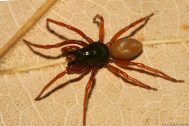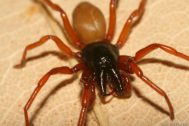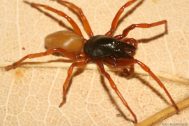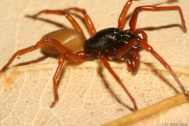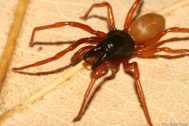| Nálezy podle období | |||||
|---|---|---|---|---|---|
| Dysderidae | 0-1900 | 1901-1950 | 1951-2000 | 2001+ | ∑ |
| Dysdera hungarica Kulczyński, 1897 Není ohrožený | 4× | 17× | 21× | ||
Dysdera hungarica Kulczyński, 1897
| České jméno | šestiočka uherská |
|---|---|
| Stupeň ohrožení | Není ohrožený |
| Nálezy | 21 nálezů, 9 kvadrátů |
| První nález |
1996, M. Matuška, Bryja, Svatoň et al. 2005 |
| Poslední nález | 2024 , Milan Řezáč, Vlastimil Růžička, Jan Dolanský |
| Areál rozšíření | European - ME (Gr., Az.) [Pan.] |
| Fytogeografická oblast |
|
| Původnost stanovišť |
|
| Vlhkost stanovišť |
|
| Stratum |
|
| Osvětlení stanovišť |
|
| Hojnost výskytu |
|
| Nadm. výška | 200-400 |
Literatura
Pavouci a sekáči (Arachnida: Araneae, Opiliones) Klánovického lesa a jeho okolí v Praze.
The studied locality, i.e. Klánovický les Forest is situated on the edge of Prague, one of the most polluted areas in the Czech Republic. Thanks to large area the forest acts as an isolation from agrochemicals, thus allowing the existence of some habitats sensitive to eutrophisation, in particular peat-bogs, heaths, bare sandy soils, and Molinia meadows. The habitats harbour unusually high species diversity of spiders and harvestmen: the author recorded 286 spider and 11 harvestman species there, which is approximately one third of the Czech fauna. Sixty one of them are red-listed in the Czech Republic. Peat-bog linyphiid Saaristoa abnormis, and steppe lycosid Alopecosa schmidti and linyphiid Panamomops inconspicuus are listed as endangered. Local small peat-bogs offer suitable conditions for disappearing lycosids Hygrolycosa rubrofasciata, Pirata piscatorius and Piratula uliginosa, while heaths harbour the disappearing Oxyopes ramosus. Water spider Argyroneta aquatica has recently been found in small pools in ditches along the railway. Littoral vegetation is inhabited by Theridiosoma gemmosum and the jumping spider Calositticus floricola. Disturbed soil surface of wet meadows harbours the wolf spider Arctosa leopardus. Some species have recently appeared at the site, for example Dysdera hungarica, the harvestman Nemastoma bidentatum sparsum or the crab spider Synema globosum. The first two were probably introduced there by man, the latter probably expands due to climate change. The author suggests to keep these habitats without woody vegetation to protect local high species diversity there.The spider genus Dysdera (Araneae, Dysderidae) in central Europe: revision and natural history
Nine species of the genus Dysdera were found to occur in central Europe: D. adriatica Kulczyński 1897, Dysdera crocata Koch 1838, D. dubrovninnii Deeleman-Reinhold 1988, Dysdera erythrina (Walckenaer 1802), Dysdera ninnii Canestrini 1868, Dysdera hungarica Kulczyński 1897, D. lantosquensis Simon 1882, D. longirostris Doblika 1853, and D. taurica Charitonov 1956. Two species, D. dubrovninnii and D. lantosquensis, are newly recorded from central Europe. The original description of D. hombergi (Scopoli 1763), the name used for a common species of the genus Harpactea, probably refers to Dysdera ninnii. We retain the name Dysdera ninnii as a nomen protectum. Dysdera hamulata Kulczyński 1897 appears to be a junior synonym of D. maurusia Thorell 1873. This North African species probably does not occur in central Europe, and a previous record from Slovakia is probably based on mislabeled material. A review of all species of Dysdera named from outside the Palearctic region demonstrated that D. australiensis Rainbow 1900 and D. magna Keyserling 1877 are junior synonyms of Dysdera crocata, and that D. bicolor Tatzanovski 1874 and D. solers Walckenaer 1837 are erroneously placed in the genus Dysdera; the former is likely to be an oonopid and the latter a caponiid. In central Europe, Dysdera spiders prefer xerothermic forests, particularly sites enriched by calcium. All species probably have biennal life-cycles. The karyotype of males of seven species were examined, and diploid chromosome numbers were found to be extraordinarily variable, ranging from 9 (Dysdera crocata) to 40 (D. longirostris). Karyotypes consist of holocentric chromosomes.Evidence for woodlice-specialization in Dysdera spiders: behavioural versus developmental approaches.
The dietary specialization in a woodlouse-eating spider Dysdera hungarica Kulczyñski (Araneae: Dysderidae) is studied using two types of laboratory experiments. In the first experiment, the rate of development of spiderlings reared on one of three diets: pure woodlice [composed of two species Oniscus asellus Linnaeus and Armadillidium vulgare (Latreille)], pure flies (Drosophila melanogaster Meigen), and a mixed woodlouse-fly diet, is studied. Spiders develop significantly faster on the woodlice-containing diets (i.e. pure woodlice and mixed diet) than on the fly diet. In the second experiment, the prey-choice for two woodlice species (O. asellus and A. vulgare) and a fly (D. melanogaster) is investigated. Dysdera hungarica spiders capture significantly more often flies than woodlice. These contrasting results reveal the different value of developmental and behavioural experiments. The dietary studies are assumed to provide better evidence of specialization than behavioural experiments, which might be misleading due to unnatural conditions. It is concluded that Dysdera hungarica is a metabolically adapted woodlice specialist. The present study thus provides the first evidence of nutritional specialization on woodlice.
Fotografie
Statistiky
Dle měsíce v roce
Dle nadmořské výšky
Dle metody sběru (21 použitých nálezů)
| Dysdera hungarica Kulczyński, 1897 ES | Samci | Samice | Mláďata | Nálezy |
|---|---|---|---|---|
| Zemní past | 0 | 45 | 0 | 9 |
| Podzemní trubkové pasti | 0 | 14 | 0 | 1 |
| Individuální sběr | 0 | 4 | 0 | 4 |
| Neurčeno | 0 | 4 | 0 | 7 |
| Samci | Samice | Mláďata | Nálezy |
Dle biotopu (20 použitých nálezů)
| Dysdera hungarica Kulczyński, 1897 ES | Samci | Samice | Mláďata | Nálezy |
|---|---|---|---|---|
| Nehluboké podzemní prostory (pukliny, půdní horizonty) | 0 | 31 | 0 | 2 |
| Suché louky | 0 | 14 | 0 | 1 |
| Polní biotopy | 0 | 1 | 0 | 1 |
| Obhospodařované pozemky | 0 | 1 | 0 | 1 |
| Neurčeno | 0 | 9 | 0 | 10 |
| Travnaté stepi | 0 | 1 | 0 | 1 |
| Těžebny písku a jiných nezpevněných hornin | 0 | 4 | 0 | 1 |
| Lesostepní doubravy | 0 | 1 | 0 | 1 |
| Skalní stepi na vápenci | 0 | 1 | 0 | 1 |
| Slaniska | 0 | 3 | 0 | 1 |
| Samci | Samice | Mláďata | Nálezy |




